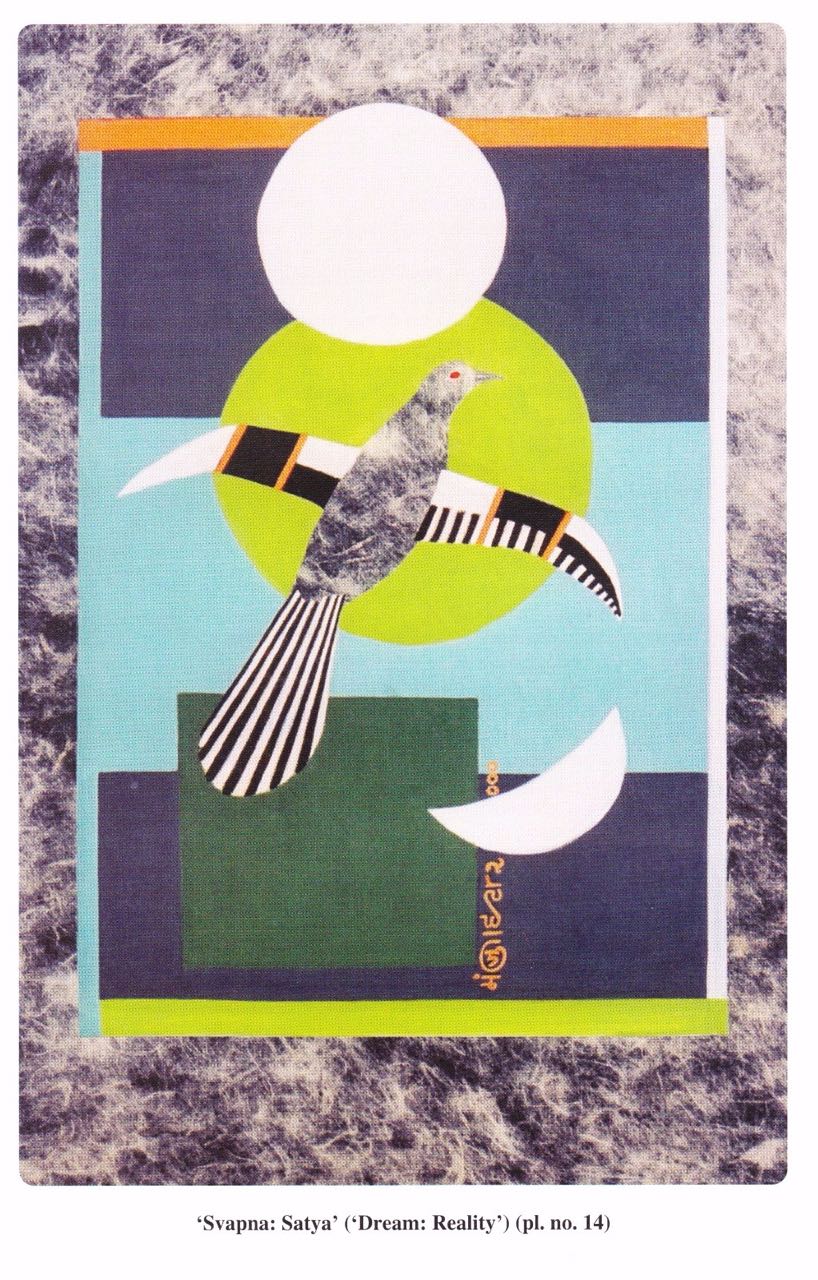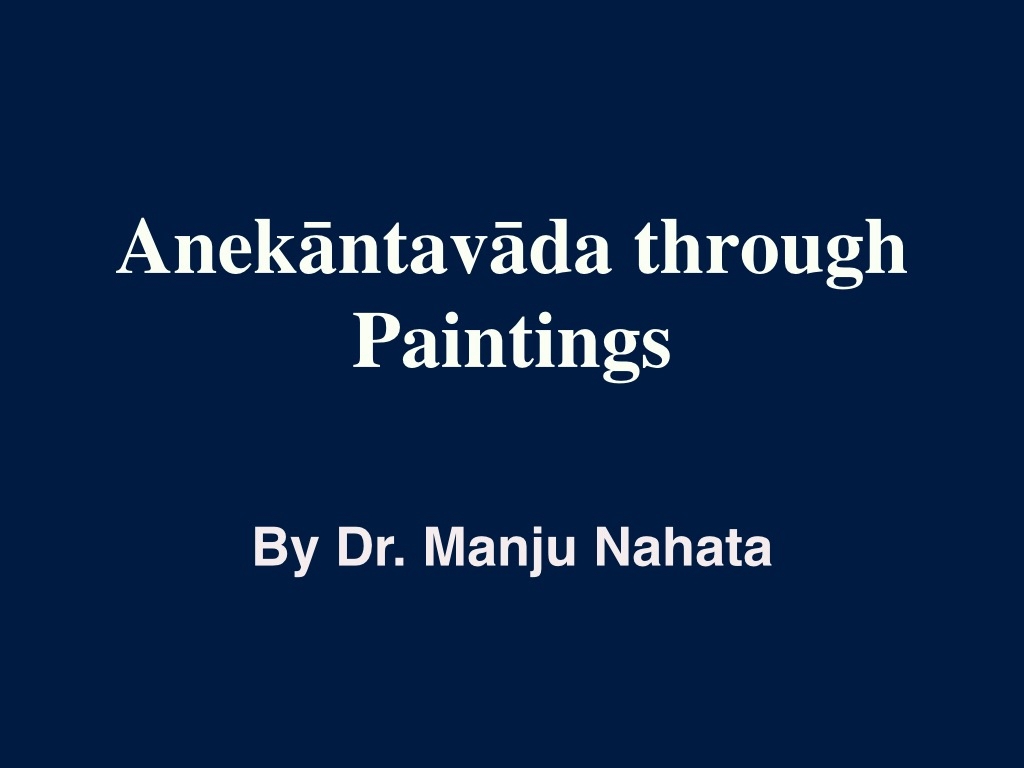
Description of the painting ‘Swapna: Satya’ (‘Dream: Reality’) according to the sixteenth chapter of Bhagavatisutra:
Shraman Mahavira before attaining kevala-gyana or the supreme knowledge dreamt ten dreams in the temple of Shulpani Yaksha at Asthika village. He dreamt ten dreams. Among these ten dreams, the third dream was of a male-cuckoo with strange wings, and by seeing it, he became ‘pratibudha’, awakened. According to Bhagavatisutra this dream meant that Lord Mahavira will interpret a strange kind of sva-samaya (swa-vada) and para-samaya (par-vada).
Pandit Dalsukh Malavaniya has clearly connected this dream with the idea of Anekantavada a. He explained the significance of the third dream in terms of non-absolutism.
According to Samantbhadra in his book Apta Mimamsa the word syat means from one point of view, without negating the other’s point of view. This depends upon the sevenfold Sapta-Bhangi and is distinguished by things to be discarded or aquired. According to the principles of Sapta-Bhangi, reality can be described in the following seven ways.
Please note here the white colour stands for ‘it is’, syat asti, ie. existence or affirmation.
While the black colour represents ‘it is not’, syat nasti i.e. non-existence or negation.
And the zebra like colour stands for ‘indeterminableness’ Avaktavya.
1. It is. (syat asti) i.e.existence
2. It is not. (syat nasti) i.e. non-existence
3. It is, it is not. (syat asti syat nasti)
4. It is indeterminable (syt avaktavya)
5. It is, It is indeterminable (syat asti, syat avaktavya)
6. It is not, It is indeterminable (syat nasti, syat avaktavya)
7. It is, It is not, It is indeterminable (syat asti, syat nasti, syat avaktavya)
Now we come to the conclusion that every object has innumerable attributes, but when considered from a certain point of view there can be 3 possibilities- it is, it is not, it is indeterminable. However as we have just seen that these 3 possibilities can have 7 combinations- both mathematically and logically. Hence proving that reality can be described in 7 ways i.e. Saptabhangi.
Acharya Samantbhadra states that whenever, we predicate either affirmatively or negatively our predication depends upon 4 aspects- matter, place, time, and state. Now, we will understand this sapta-bhanga with respect to these four aspects.
In this painting the matter is the bird itself; the dark green square denotes the place. The sun and the moon painted in white stand for time; and the light green circle behind the bird denotes the state, that the bird is in the state of flying. The name of the painting, ‘Svapna: Satya’ (Dream: Reality), itself denotes Anekantavada. Generally dreams are considered to be a creation of mind whereas reality exists outside the mind as well. Shraman Mahavira’s dream itself became a truth.

Anekāntavāda is regarded as the central philosophy of Jainism. This is a theory of many sidedness of reality and truth. The identity of real is not contradicted by the possession of varying attributes. Reality according to Jains is permanent in the midst of changes. It means that things must not be judged from one point of view, as it has many aspects. The derivative meaning of the word anekāntavāda given by Vimal Das (17th cent. CE) in his book Saptabhaṅgī Taraṅgiṇī:
aneke antāḥ svabhāvāḥ yasmin vāde sah anekāntavādaḥ
The word Anekanta is made out of two words: "Aneka" and "anta". "Aneka" means many, more than one and "Anta" means attributes, qualities, nature. Here when we say that an object has infinite attributes, we are actually saying that an object is capable of undergoing infinite modifications.
Amrutchandrasuri interpreted this theory clearly and extensively. In Samaysara Atmakhyati he says:
ekavastu-vastutva-niṣpādakaṃparaspara- viruddha-śakti-dvaya-prakāśanamanekāntaḥ
(Anekānta means delineating two self-contradictory attributes which form the essence of an object.)
Jain philosophy emphasizes the concept that nothing in this world is either constant or variable; it believes that nothing is either eternal or perishable; but, on the contrary, everything is a compound of nityānitya or permanence-impermanence. Thus, this age-old philosophy makes us aware of the unquestionable co-existence of antitheses/opposites in this world. For instance, the concomitance of the universal-particular, the constant-variable, the unity-plurality, and the appearance-reality antitheses. It emphasises that this co-existence is actually favorable for an everlasting synthesis. But we should take note of the fact that in this antithesis nothing, which stands in opposition to the other, rejects each other. Thus, they are mutually interdependent, giving a touch of fullness to our essential understanding of a thing or event.
We can find some traits and characteristics of Anekāntavāda, in, say, Vedānta, Vaiśeṣika, Buddhist, Caraka and so forth; but it is the Jain ācāryas who have elaborated the theme in its entirety in the last 2000 years. Starting from the great ācāryas, namely Umāsvāti, Kundakunda, Samantbhadra, Siddhasena, Mallavādī, Jinabhadra, Haribhadrasūri, Akalaṅka, Vidyānandasvāmī, Prabhācandra, Vādidevasūri, Yaśovijaya and Mahāprajña etc.. Their contributions developed anekāntavāda gradually and ultimately created a powerhouse of knowledge.
 Dr. Manju Nahata
Dr. Manju Nahata